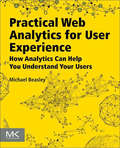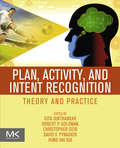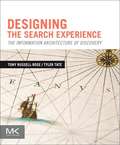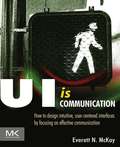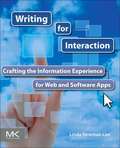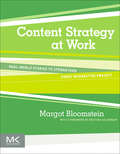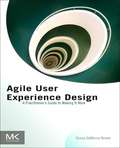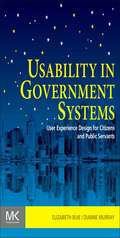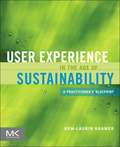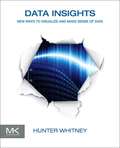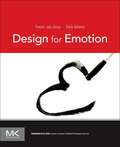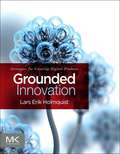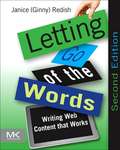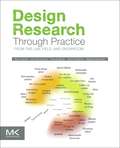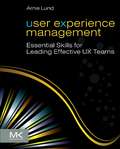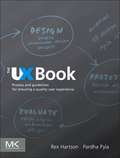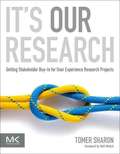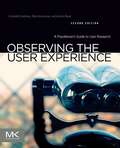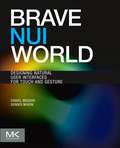- Table View
- List View
Digital Outcasts: Moving Technology Forward without Leaving People Behind
by Kel SmithThe blind person who tries to make an online purchase. The young girl who cannot speak due to a cognitive disability. The man confined to his home due to permanent injury. The single mother with a long-term illness who struggles to feed her family. With one in seven people worldwide currently living with a disability, the term "outcast" covers numerous scenarios. Digital outcasts rely on technology for everyday services that many people take for granted. However, poorly designed products risk alienating this important (and growing) population. Through a "grass roots" approach to innovation, digital outcasts are gradually taking action to transform their lives and communities. This emerging trend provides exciting learning opportunities for all of us. Citing real-world case studies from healthcare to social science, this book examines the emerging legal and cultural impact of inclusive design. Gain a better understanding of how people with disabilities use technology Discover pitfalls and approaches to help you stay current in your UX practices Anticipate a future in which ambient benefit can be achieved for people of all abilities and backgrounds
Practical Web Analytics for User Experience: How Analytics Can Help You Understand Your Users
by Michael BeasleyPractical Web Analytics for User Experience teaches you how to use web analytics to help answer the complicated questions facing UX professionals. Within this book, you'll find a quantitative approach for measuring a website's effectiveness and the methods for posing and answering specific questions about how users navigate a website. The book is organized according to the concerns UX practitioners face. Chapters are devoted to traffic, clickpath, and content use analysis, measuring the effectiveness of design changes, including A/B testing, building user profiles based on search habits, supporting usability test findings with reporting, and more. This is the must-have resource you need to start capitalizing on web analytics and analyze websites effectively.Discover concrete information on how web analytics data support user research and user-centered design Learn how to frame questions in a way that lets you navigate through massive amounts of data to get the answer you needLearn how to gather information for personas, verify behavior found in usability testing, support heuristic evaluation with data, analyze keyword data, and understand how to communicate these findings with business stakeholders
Visual Usability: Principles and Practices for Designing Digital Applications
by Tania Schlatter Deborah LevinsonImagine how much easier creating web and mobile applications would be if you had a practical and concise, hands-on guide to visual design. Visual Usability gets into the nitty-gritty of applying visual design principles to complex application design. You’ll learn how to avoid common mistakes, make informed decisions about application design, and elevate the ordinary. We’ll review three key principles that affect application design – consistency, hierarchy, and personality – and illustrate how to apply tools like typography, color, and layout to digital application design. Whether you’re a UI professional looking to fine-tune your skills, a developer who cares about making applications beautiful and usable, or someone entirely new to the design arena, Visual Usability is your one-stop, practical guide to visual design.Discover the principles and rules that underlie successful application design Learn how to develop a rationale to support design strategy and move teams forwardMaster the visual design toolkit to increase user-friendliness and make complicated processes feel straightforward for your product
Plan, Activity, and Intent Recognition: Theory and Practice
by Gita Sukthankar, Christopher Geib, Hung Hai Bui, David V. Pynadath and Robert P. GoldmanPlan recognition, activity recognition, and intent recognition together combine and unify techniques from user modeling, machine vision, intelligent user interfaces, human/computer interaction, autonomous and multi-agent systems, natural language understanding, and machine learning. Plan, Activity, and Intent Recognition explains the crucial role of these techniques in a wide variety of applications including: personal agent assistants computer and network security opponent modeling in games and simulation systems coordination in robots and software agents web e-commerce and collaborative filtering dialog modeling video surveillance smart homes In this book, follow the history of this research area and witness exciting new developments in the field made possible by improved sensors, increased computational power, and new application areas.Combines basic theory on algorithms for plan/activity recognition along with results from recent workshops and seminarsExplains how to interpret and recognize plans and activities from sensor dataProvides valuable background knowledge and assembles key concepts into one guide for researchers or students studying these disciplines
Designing the Search Experience: The Information Architecture of Discovery
by Tony Russell-Rose Tyler TateSearch is not just a box and ten blue links. Search is a journey: an exploration where what we encounter along the way changes what we seek. But in order to guide people along this journey, designers must understand both the art and science of search.In Designing the Search Experience, authors Tony Russell-Rose and Tyler Tate weave together the theories of information seeking with the practice of user interface design. Understand how people search, and how the concepts of information seeking, information foraging, and sensemaking underpin the search processApply the principles of user-centered design to the search box, search results, faceted navigation, mobile interfaces, social search, and much moreDesign the cross-channel search experiences of tomorrow that span desktop, tablet, mobile, and other devices
UI is Communication: How to Design Intuitive, User Centered Interfaces by Focusing on Effective Communication
by Everett N McKayUser interface design is a challenging, multi-disciplinary activity that requires understanding a wide range of concepts and techniques that are often subjective and even conflicting. Imagine how much it would help if there were a single perspective that you could use to simplify these complex issues down to a small set of objective principles. In UI is Communication, Everett McKay explains how to design intuitive user interfaces by focusing on effective human communication. A user interface is ultimately a conversation between users and technology. Well-designed user interfaces use the language of UI to communicate to users efficiently and naturally. They also recognize that there is an emotional human being at the other end of the interaction, so good user interfaces strive to make an emotional connection. Applying what you learn from UI is Communication will remove much of the mystic, subjectiveness, and complexity from user interface design, and help you make better design decisions with confidence. It’s the perfect introduction to user interface design.Approachable, practical communication-based guide to interaction and visual design that you can immediately apply to projects to make solid design decisions quickly and confidentlyIncludes design makeovers so you can see the concepts in practice with real examplesCommunication-based design process ties everything from interaction to visual design together
Writing for Interaction: Crafting the Information Experience for Web and Software Apps
by Linda Newman LiorWriting for Interaction focuses on the art of creating the information experience as it appears within software and web applications, specifically in the form of user interface text. It also provides strategies for ensuring a consistent, positive information experience across a variety of delivery mechanisms, such as online help and social media. Throughout this book, you'll learn simple techniques for writing consistent text with the right tone, how to select content delivery mechanisms, and how straightforward, clear layouts help your customer interact with your application. Divided into five sections, the book completely covers the information experience design process from beginning to end. You'll cover everything from understanding your users and their needs, to creating personas, designing the IX strategy, creating your information, and evaluating the resulting information experience. This is your one-stop reference for information experience!Illuminates writing principles and practices for use in interactive design Includes examples, checklists, and sample processes, highlighting practical approaches to designing the information experience Provides the complete picture: understanding customer needs, creating personas, and writing the text appearing within the user interface
Content Strategy at Work: Real-world Stories to Strengthen Every Interactive Project
by Margot BloomsteinContent is king… and the new kingmaker… and your message needs to align with your model and metrics and other mumbo jumbo, right? Whether you’re slogging through theory or buzzwords, there’s no denying content strategy is coming of age. But what’s in it for you? And if you’re not a content strategist, why should you care? Because even if content strategy isn’t your job, content’s probably your problem—and probably more than you think. You or your business has a message you want to deliver, right? You can deliver that message through various channels and content types, from Tweets to testimonials and photo galleries galore, and your audience has just as many ways of engaging with it. So many ways, so much content… so where’s the problem? That is the problem. And you can measure it in time, creativity, money, lost opportunity, and the sobs you hear equally from creative directors, project managers, and search engine marketing specialists. The solution is content strategy, and this book offers real-world examples and approaches you can adopt, no matter your role on the team. Put content strategy to work for you by gathering this book into your little hands and gobbling up never-before seen case studies from teams at Johns Hopkins Medicine, MINI, Icebreaker, and more. Content Strategy at Work is a book for designers, information architects, copywriters, project managers, and anyone who works with visual or verbal content. It discusses how you can communicate and forge a plan that will enable you, your company, or your client get that message across and foster better user experiences. Presents a content strategy framework and ways to implement in both in-house marketing departments and consultanciesIncludes case studies, interviews, and lessons learned from retail, apparel, network television, business-to-business, automotive, non-profit, and higher ed brandsDetails practical sales techniques to sell content strategy and use content strategy processes to sell other services and larger projects
Individual Differences and Personality
by Michael C. AshtonHow do we come to be who we are? Why do we differ in our personalities? How do these differences matter in life? Individual Differences and Personality aims to describe how and why personality varies among people. Unlike books that focus on individual theorists, this book focuses on current research and theory on the nature of personality and related individual differences. The book begins by discussing how personality is measured, the concept of a personality trait, and the basic dimensions of personality. This leads to a discussion of the origins of personality, with descriptions of its developmental course, its biological causes, its genetic and environmental influences, and its evolutionary function. The concept of a personality disorder is then described, followed by a discussion of the influence of personality on life outcomes in relationships, work, and health. Finally, the book examines the important differences between individuals in the realms of mental abilities, of beliefs and attitudes, and of behavior.Presents a scientific approach to personality and related individual differences, as well as theory and research on the fundamental questions about human psychological variationNew edition presents findings from dozens of new research studies of the past six yearsIncludes new chapter on vocational interests and a revised chapter on personality disorders reflecting DSM-5 formulationContains streamlined descriptions of measurement concepts and heritability research Includes various boxes containing interesting asides that help to maintain the student’s attention
Agile User Experience Design: A Practitioner’s Guide to Making It Work
by Diana BrownBeing able to fit design into the Agile software development processes is an important skill in today’s market. There are many ways for a UX team to succeed (and fail) at being Agile. This book provides you with the tools you need to determine what Agile UX means for you. It includes practical examples and case studies, as well as real-life factors to consider while navigating the Agile UX waters. You’ll learn about what contributes to your team’s success, and which factors to consider when determining the best path for getting there. After reading this book, you’ll have the knowledge to improve your software and product development with Agile processes quickly and easily. Includes hands on, real-world examples to illustrate the successes and common pitfalls of Agile UXIntroduces practical techniques that can be used on your next projectDetails how to incorporate user experience design into your company's agile software/product process
Usability in Government Systems: User Experience Design for Citizens and Public Servants
by Elizabeth Buie Dianne MurrayAs a usability specialist or interaction designer working with the government, or as a government or contractor professional involved in specifying, procuring, or managing system development, you need this book. Editors Elizabeth Buie and Dianne Murray have brought together over 30 experts to outline practical advice to both usability specialists and government technology professionals and managers. Working with internal and external government systems is a unique and difficult task because of of the sheer magnitude of the audience for external systems (the entire population of a country, and sometimes more), and because of the need to achieve government transparency while protecting citizens’ privacy.. Open government, plain language, accessibility, biometrics, service design, internal vs. external systems, and cross-cultural issues, as well as working with the government, are all covered in this book.Covers both public-facing systems and internal systems run by governmentsDetails usability and user experience approaches specific to government websites, intranets, complex systems, and applicationsProvides practical material that allows you to take the information and immediately use it to make a difference in your projects
User Experience in the Age of Sustainability: A Practitioner’s Blueprint
by Kem-Laurin KramerUser Experience in the Age of Sustainability focuses on the economic, sociological and environmental movement in business to make all products including digital ones more sustainable. Not only are businesses finding a significant ROI from these choices, customers are demanding this responsible behaviour. The author looks at user experience practice through the lens of sustainability whether it be a smart phone, service – based subscription solutions or sustainable packaging to expose the ways in which user researchers and designers can begin to connect to the sustainability not merely as a theoretical. This book has a practical take on the matter providing a framework along with case studies and personal stories from doing this work successfully. Both hardware and software design are covered. Learn about the fundamentals of sustainability and how it can change the future of user experience professionals Learn how to integrate sustainability into designs with a solid framework using user research methodology, techniques, and purposeful metrics Find out how to integrate sustainability frameworks into the software and product development cycles Find out how sustainability applies to mobile and digital products with discussions on user messaging, dematerialization, and efficient design See how companies have made it work with case studies
Data Insights: New Ways to Visualize and Make Sense of Data
by Hunter WhitneyData Insights: New Ways to Visualize and Make Sense of Data offers thought-provoking insights into how visualization can foster a clearer and more comprehensive understanding of data. The book offers perspectives from people with different backgrounds, including data scientists, statisticians, painters, and writers. It argues that all data is useless, or misleading, if we do not know what it means. Organized into seven chapters, the book explores some of the ways that data visualization and other emerging approaches can make data meaningful and therefore useful. It also discusses some fundamental ideas and basic questions in the data lifecycle; the process of interactions between people, data, and displays that lead to better questions and more useful answers; and the fundamentals, origins, and purposes of the basic building blocks that are used in data visualization. The reader is introduced to tried and true approaches to understanding users in the context of user interface design, how communications can get distorted, and how data visualization is related to thinking machines. Finally, the book looks at the future of data visualization by assessing its strengths and weaknesses. Case studies from business analytics, healthcare, network monitoring, security, and games, among others, as well as illustrations, thought-provoking quotes, and real-world examples are included. This book will prove useful to computer professionals, technical marketing professionals, content strategists, Web and product designers, and researchers.Demonstrates, with a variety of case studies, how visualizations can foster a clearer and more comprehensive understanding of data Answers the question, "How can data visualization help me?" with discussions of how it fits into a wide array of purposes and situations Makes the case that data visualization is not just about technology; it also involves a deeply human process
Measures of Personality and Social Psychological Constructs
by Gerald Matthews Gregory Boyle Donald H. SaklofskeMeasures of Personality and Social Psychological Constructs assists researchers and practitioners by identifying and reviewing the best scales/measures for a variety of constructs. Each chapter discusses test validity, reliability, and utility. Authors have focused on the most often used and cited scales/measures, with a particular emphasis on those published in recent years. Each scale is identified and described, the sample on which it was developed is summarized, and reliability and validity data are presented, followed by presentation of the scale, in full or in part, where such permission has been obtained. Measures fall into five broad groups. The emotional disposition section reviews measures of general affective tendencies, and/or cognitive dispositions closely linked to emotion. These measures include hope and optimism, anger and hostility, life satisfaction, self-esteem, confidence, and affect dimensions. Emotion regulation scales go beyond general dispositions to measure factors that may contribute to understanding and managing emotions. These measures include alexithymia, empathy, resiliency, coping, sensation seeking, and ability and trait emotional intelligence. The interpersonal styles section introduces some traditional social–psychological themes in the context of personality assessment. These measures include adult attachment, concerns with public image and social evaluation, and forgiveness. The vices and virtues section reflects adherence to moral standards as an individual characteristic shaped by sociocultural influences and personality. These measures include values and moral personality, religiosity, dark personalities (Machiavellianism,narcissism, and subclinical psychopathy), and perfectionism. The sociocultural interaction and conflict section addresses relationships between different groups and associated attitudes. These measures include cross-cultural values, personality and beliefs, intergroup contact, stereotyping and prejudice, attitudes towards sexual orientation, and personality across cultures.Encompasses 25 different areas of psychology researchEach scale has validity, reliability info, info on test bias, etcMultiple scales discussed for each constructDiscussion of which scales are appropriate in which circumstances and to what populationsExamples of scales included
Design for Emotion
by Trevor van Gorp Edie AdamsDesign for Emotion introduces you to the why, what, when, where and how of designing for emotion. Improve user connection, satisfaction and loyalty by incorporating emotion and personality into your design process. The conscious and unconscious origins of emotions are explained, while real-world examples show how the design you create affects the emotions of your users. This isn’t just another design theory book – it’s imminently practical. Design for Emotion introduces the A.C.T. Model (Attract/Converse/Transact) a tool for helping designers create designs that intentionally trigger emotional responses. This book offers a way to harness emotions for improving the design of products, interfaces and applications while also enhancing learning and information processing. Design for Emotion will help your designs grab attention and communicate your message more powerfully, to more people. Explains the relationship between emotions and product personalitiesDetails the most important dimensions of a product's personalityExamines models for understanding users' relationships with productsExplores how to intentionally design product personalities Provides extensive examples from the worlds of product, web and application designIncludes a simple and effective model for creating more emotional designs
Grounded Innovation: Strategies for Creating Digital Products
by Lars Erik HolmquistGrounded Innovation: Strategies for Creating Digital Products focuses on the innovation processes and technical properties of digital products. Drawing on case studies, the book looks at systematic ways to ground innovation in both technology and human needs, and it explores how digital products have become integrated in the real world. It provides guidelines to innovation in a new technical environment, including prototyping and testing, within the cultural or financial parameters of a business. The book is divided into two parts. Part 1 discusses the history and the basic properties of digital products; the different approaches to innovation; the concept of grounded innovation; and concepts and processes that are important for creating successful innovations such as inquiry, invention, and prototyping. Part 2 demonstrates how the basic properties of digital products can be used as raw material for new innovations, including interaction, networking, sensing, and proactivity. There is also a discussion on recent technology, such as rapid prototyping and mobile mash-ups. A wide variety of examples show how novel technical and conceptual innovations became commercial breakthroughs. Grounded Innovation is ideal for product designers, interaction designers, and design-oriented engineers. It will also be a valuable resource for anyone interested in understanding how digital products are created and in a general approach to information technology. Wide variety of examples show how novel technical and conceptual innovations became commercial breakthroughsProvides guidelines to innovation in a new technical environment including prototyping and testingDiscusses how to innovate within the cultural or financial parameters of a business
Letting Go of the Words: Writing Web Content that Works (Interactive Technologies)
by Janice (Ginny) RedishWeb site design and development continues to become more sophisticated. An important part of this maturity originates with well-laid-out and well-written content. Ginny Redish is a world-renowned expert on information design and how to produce clear writing in plain language for the web. All of the invaluable information that she shared in the first edition is included with numerous new examples. New information on content strategy for web sites, search engine optimization (SEO), and social media make this once again the only book you need to own to optimize your writing for the web.New material on content strategy, search engine optimization, and social mediaLots of new and updated examplesMore emphasis on new hardware like tablets, iPads, and iPhones
Design Research Through Practice: From the Lab, Field, and Showroom
by Thomas Binder Ilpo Koskinen Johan Redstrom John Zimmerman Stephan WensveenDesign Research Through Practice: From the Lab, Field, and Showroom focuses on one type of contemporary design research known as constructive design research. It looks at three approaches to constructive design research: Lab, Field, and Showroom. The book shows how theory, research practice, and the social environment create commonalities between these approaches. It illustrates how one can successfully integrate design and research based on work carried out in industrial design and interaction design. The book begins with an overview of the rise of constructive design research, as well as constructive research programs and methodologies. It then describes the logic of studying design in the laboratory, design ethnography and field work, and the origins of the Showroom and its foundation on art and design rather than on science or the social sciences. It also discusses the theoretical background of constructive design research, along with modeling and prototyping of design items. Finally, it considers recent work in Lab that focuses on action and the body instead of thinking and knowing. Many kinds of designers and people interested in design will find this book extremely helpful. Gathers design research experts from traditional lab science, social science, art, industrial design, UX and HCI to lend tested practices and how they can be used in a variety of design projectsProvides a multidisciplinary story of the whole design process, with proven and teachable techniques that can solve both academic and practical problemsPresents key examples illustrating how research is applied and vignettes summarizing the key how-to details of specific projects
User Experience Management: Essential Skills for Leading Effective UX Teams
by Arnie LundUser Experience Management: Essential Skills for Leading Effective UX Teams deals with specific issues associated with managing diverse user experience (UX) skills, often in corporations with a largely engineering culture. Part memoir and part handbook, it explains what it means to lead a UX team and examines the management issues of hiring, inheriting, terminating, layoffs, interviewing and candidacy, and downsizing. The book offers guidance on building and creating a UX team, as well as equipping and focusing the team. It also considers ways of nurturing the team, from coaching and performance reviews to conflict management and creating work-life balance. Furthermore, it discusses the essential skills needed in leading an effective team and developing a communication plan. This book will be valuable to new managers and leaders, more experienced managers, and anyone who is leading or managing UX groups or who is interested in assuming a leadership role in the future.Gives a UX leadership boot-camp from putting together a winning team, to giving them a driving focus, to acting as their spokesman, to handling difficult situationsFull of practical advice and experiences for managers and leaders in virtually any area of the user experience fieldContains best practices, real-world stories, and insights from UX leaders at IBM, Microsoft, SAP, and many more!
The UX Book: Process and Guidelines for Ensuring a Quality User Experience
by Rex Hartson Pardha PylaThe UX Book: Process and Guidelines for Ensuring a Quality User Experience aims to help readers learn how to create and refine interaction designs that ensure a quality user experience (UX). The book seeks to expand the concept of traditional usability to a broader notion of user experience; to provide a hands-on, practical guide to best practices and established principles in a UX lifecycle; and to describe a pragmatic process for managing the overall development effort. The book provides an iterative and evaluation-centered UX lifecycle template, called the Wheel, for interaction design. Key concepts discussed include contextual inquiry and analysis; extracting interaction design requirements; constructing design-informing models; design production; UX goals, metrics, and targets; prototyping; UX evaluation; the interaction cycle and the user action framework; and UX design guidelines. This book will be useful to anyone interested in learning more about creating interaction designs to ensure a quality user experience. These include interaction designers, graphic designers, usability analysts, software engineers, programmers, systems analysts, software quality-assurance specialists, human factors engineers, cognitive psychologists, cosmic psychics, trainers, technical writers, documentation specialists, marketing personnel, and project managers. A very broad approach to user experience through its components—usability, usefulness, and emotional impact with special attention to lightweight methods such as rapid UX evaluation techniques and an agile UX development process Universal applicability of processes, principles, and guidelines—not just for GUIs and the Web, but for all kinds of interaction and devices: embodied interaction, mobile devices, ATMs, refrigerators, and elevator controls, and even highway signage Extensive design guidelines applied in the context of the various kinds of affordances necessary to support all aspects of interaction Real-world stories and contributions from accomplished UX practitioners A practical guide to best practices and established principles in UX A lifecycle template that can be instantiated and tailored to a given project, for a given type of system development, on a given budget
Exceptional Life Journeys: Stories of Childhood Disorder
by Jac Andrews Peter IstvanffyMost students in training to become teachers, psychologists, physicians, and social workers as well as many practicing professionals in these disciplines do not get the opportunity to fully understand and appreciate the circumstances of children ,parents, and teachers who have had to cope and adapt to childhood disorder. Most professionals in the field of childhood disorders are well trained in assessment and treatment methods and are aware of the clinical, theoretical, and empirical foundations of the work they do. In their training, they get some experience in diagnosing the educational, psychological, social, and medical problems of children through their supervised clinical internships. In their training and in their professional practice they get to interview, discuss, consult and collaborate with children and their families regarding developmental issues and treatment plans, however, they rarely get an opportunity to fully realize and understand what it is like to have a disorder and what it is like to be a mother, or father, or teacher of children with disorders. This book provides an opportunity for students in training and professionals in the field to gain some awareness of the life journeys of some exceptional children, their families and their teachers. Focuses on those childhood disorders that are most common or what are sometimes referred to as high incidence disorders such as learning disabilities, autism, behavior disorder, depression, and anxietyBeyond, a clinical, empirical, and theoretical description of childhood disorders or a personal account relative to one particular disorder, this book provides rich narratives of experience from multiple perspectives with respect to numerous childhood disordersProvides readers with insight by sharing examples of personal contexts and situations, significant life issues, challenges and barriers, successes, and recommendations relative to particular circumstances
The Initial Psychotherapy Interview: A Gay Man Seeks Treatment
by Charles SilversteinThis book provides comprehensive coverage of the initial interview with a gay male client. It first provides a transcript of the entire interview. It then covers in-depth a set of universal themes, and finally includes commentary on and analysis of the interview from a range of the most widely used theoretical perspectives. It is designed to teach the foundations of conducting an initial interview and therapists in training, as well as experienced mental health workers will find it invaluable. --Winner of the Distinguished Book Award, APA 2011--Editor is Chairman of the Board of Directors of the Institute for Human IdentityPresents a realistic model of interviewing, and cautions the therapist in training not to grasp for the unreachable; perfectionEvery chapter in the book discusses the insights and mistakes by the psychologist conducting the interview
It's Our Research: Getting Stakeholder Buy-in for User Experience Research Projects
by Tomer SharonIt’s Our Research: Getting Stakeholder Buy-in for User Experience Research Projects discusses frameworks, strategies, and techniques for working with stakeholders of user experience (UX) research in a way that ensures their buy-in. This book consists of six chapters arranged according to the different stages of research projects. Topics discussed include the different roles of business, engineering, and user-experience stakeholders; identification of research opportunities by developing empathy with stakeholders; and planning UX research with stakeholders. The book also offers ways of teaming up with stakeholders; strategies to improve the communication of research results to stakeholders; and the nine signs that indicate that research is making an impact on stakeholders, teams, and organizations. This book is meant for UX people engaged in usability and UX research. Written from the perspective of an in-house UX researcher, it is also relevant for self-employed practitioners and consultants who work in agencies. It is especially directed at UX teams that face no-time-no-money-for-research situations.Named a 2012 Notable Computer Book for Information Systems by Computing ReviewsFeatures a series of video interviews with UX practitioners and researchersProvides dozens of case studies and visuals from international research practitionersProvides a toolset that will help you justify your work to stakeholders, deal with office politics, and hone your client skillsPresents tried and tested techniques for working to reach positive, useful, and fruitful outcomes
Observing the User Experience: A Practitioner's Guide to User Research (Morgan Kaufmann Series In Interactive Technologies)
by Elizabeth Goodman Mike Kuniavsky Andrea MoedObserving the User Experience: A Practitioner’s Guide to User Research aims to bridge the gap between what digital companies think they know about their users and the actual user experience. Individuals engaged in digital product and service development often fail to conduct user research. The book presents concepts and techniques to provide an understanding of how people experience products and services. The techniques are drawn from the worlds of human-computer interaction, marketing, and social sciences. The book is organized into three parts. Part I discusses the benefits of end-user research and the ways it fits into the development of useful, desirable, and successful products. Part II presents techniques for understanding people’s needs, desires, and abilities. Part III explains the communication and application of research results. It suggests ways to sell companies and explains how user-centered design can make companies more efficient and profitable. This book is meant for people involved with their products’ user experience, including program managers, designers, marketing managers, information architects, programmers, consultants, and investors. Explains how to create usable products that are still original, creative, and uniqueA valuable resource for designers, developers, project managers - anyone in a position where their work comes in direct contact with the end userProvides a real-world perspective on research and provides advice about how user research can be done cheaply, quickly and how results can be presented persuasivelyGives readers the tools and confidence to perform user research on their own designs and tune their software user experience to the unique needs of their product and its users
Brave NUI World: Designing Natural User Interfaces for Touch and Gesture
by Daniel Wigdor Dennis WixonBrave NUI World is the first practical guide for designing touch- and gesture-based user interfaces. Written by the team from Microsoft that developed the multi-touch, multi-user Surface® tabletop product, it introduces the reader to natural user interfaces (NUI). It gives readers the necessary tools and information to integrate touch and gesture practices into daily work, presenting scenarios, problem solving, metaphors, and techniques intended to avoid making mistakes. This book considers diverse user needs and context, real world successes and failures, and the future of NUI. It presents thirty scenarios, giving practitioners a multitude of considerations for making informed design decisions and helping to ensure that missteps are never made again. The book will be of value to game designers as well as practitioners, researchers, and students interested in learning about user experience design, user interface design, interaction design, software design, human computer interaction, human factors, information design, and information architecture. Provides easy-to-apply design guidance for the unique challenge of creating touch- and gesture-based user interfacesConsiders diverse user needs and context, real world successes and failures, and a look into the future of NUIPresents thirty scenarios, giving practitioners a multitude of considerations for making informed design decisions and helping to ensure that missteps are never made again

